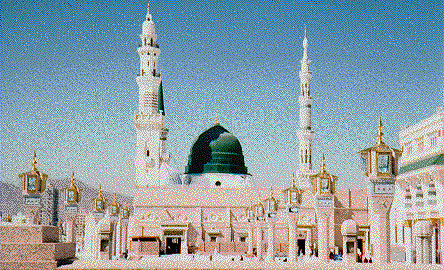The Mosque of the Prophet was built in 622 by the Muslims of Medina immediately adjacent to the Prophet Muhammed’s house. It began as a small square enclosure made of mud-brick, accessed through three doors: Bab Rahmah to the south, Bab Jibril to the west and Bab al-Nisa' to the east. Within this enclosure, the Prophet aligned the prayer space facing north towards Jerusalem. After the revelation of Surat al-Baqara, the qibla direction was reset to face Masjid al-Haram, and the Ka'ba in the city of Mecca.
The mosque was expanded several times after the Prophet’s death. In 707, Umayyad Caliph al-Walid (705-715) tore down the old structure, and build a larger mosque with stone foundations and a teak roof supported on stone columns. The new mosque included the house of the Prophet under which he was buried. The mosque walls were decorated with mosaics by Coptic and Greek craftsmen similar to the decoration of the Umayyad mosque in Damascus and the one of the Dome of the Rock in Jerusalem built by the same caliph. The courtyard was surrounded by a gallery on four sides and four minarets added to its corners.
Abbasid Caliph al-Mahdi (775-785) added twenty doors to the mosque, eight on each of the east and west walls, and four on the north wall.
During the reign of the Mamluk Sultan Qala'un, a dome was erected above the house and tomb of the Prophet and an ablution fountain was built outside of Bab al-Salam.
Sultan Nasir bin Muhammad bin Qala'un rebuilt the fourth minaret that had been destroyed earlier.
Sultan Qaytbay rebuilt the east, west and qibla walls in 1481.
The Ottoman Sultan Suleyman I (1520-1566) rebuilt the western and eastern walls of the mosque and built the northeastern minaret known as al-Suleymaniyya. A new mihrab, called al-Ahnaf, was built next to the Prophet's mihrab known as al-Shafi'iyyah.
The Ottoman Sultan Abdulmecid I (1839-1861), doubled in width the prayer hall added small domes to cover it. The domes were decorated with Qur’anic verses and lines from thirteenth century Arabic poetry. The tiles on the qibla wall were also decorated with Qur’anic calligraphy. The floors of the prayer hall and the courtyard were paved with marble and red stones and a fifth minaret, al-Majidiyya, was built to the west of the enclosure.
During the reign of Saudi King Abdul Aziz (1932-1953), new wings to the east and west of the prayer hall were added. The Suleymaniyya and Majidiyya minarets were replaced by two Mamluk style minarets. Two more minarets were added to the northeast and northwest of the mosque. A library was built to house historic Qu’rans and books on religion.
In 1981 the mosque new prayer areas were added to accommodate the growing number of worshipers.
Today the mosque incorporates all the elements of its history as well as modern adjustments for ventilation, escalators to accommodate the traffic, shading for the exposed spaces. The mosque enclosure is a hundred times the size of the first mosque built by the Prophet and it can accommodate half a million worshippers at any one time.


